Before getting into troubleshooting, let's look at the circuit.
Supervision - Checking Continuity
From what you're saying, you have a NAC1 trouble on your panel. On a Notification Appliance Circuit (NAC Circuit), the panel doesn't check to see if the devices are working, the panel only supervises the wires by checking the continuity of the wires.
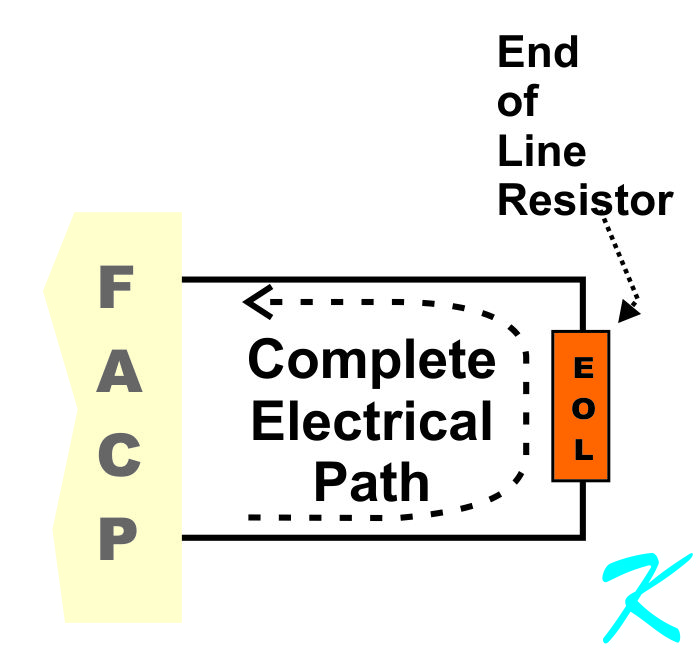
As long as the electrical current is flowing through the wires, along with the end of line resistor, the panel assumes that there is not any trouble.
Backward Voltage
When the panel is in supervision mode, not sounding the alarm, electrical current should not go through the horns or strobes. In other words, when the panel isn't sounding the alarm, the voltage on the NAC circuit is backward.
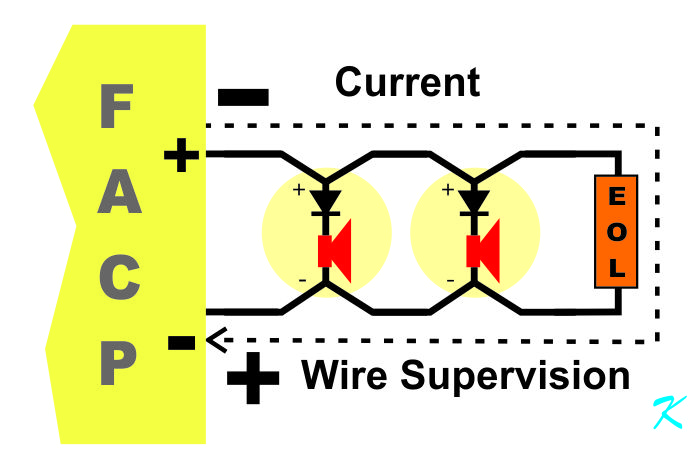
When supervising, the
plus screw terminals on the panel, and on the horns and strobes, is
negative; and the
minus screw terminals on the panel, and on the horns and strobes, is
positive. Yes, that is correct, the voltage is backward.
Later, when the panel does sound the alarm, the panel changes the voltage. For sounding the alarm, current has to go through the horns and strobes, so the voltage is correct according to the labels when sounding the alarm.
Normal Circuit
Normally, the panel is supervising the wires.
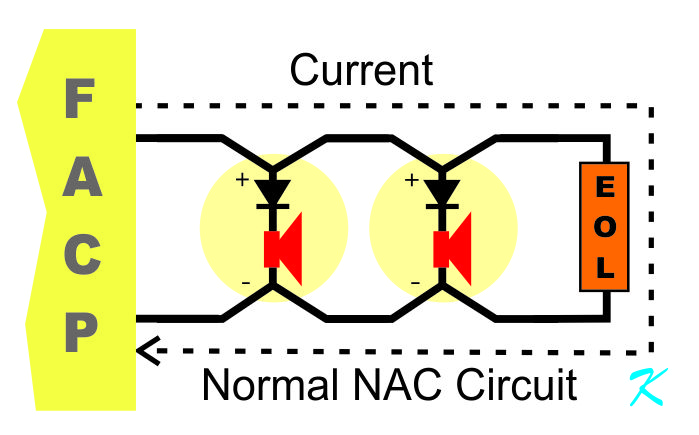
The end of line resistor at the end of the circuit allows a little current to pass, but not too much current. That way, the panel knows that the wires are connected through, and the circuit is working normally.
You can see what a normal supervision voltage should be on the NAC outputs of the panel by measuring the voltage on the panel's NAC 2 screw terminals. Check that voltage now. Later you may just need to know the normal supervision voltage.
Open Wire
More often than not, the trouble the NAC circuit is caused by an open circuit, stopping the current.
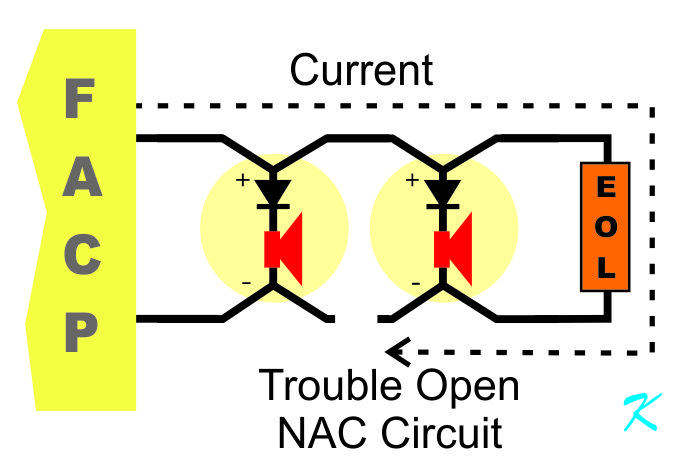
When a wire breaks or comes loose from a screw terminal, the current stops, and the panel turns on its trouble light and trouble buzzer.
The voltage on the panel's NAC 1 screw terminals will be higher than the voltage on NAC 2 screw terminals. At the end of line resistor, the voltage will probably be zero.
Somewhere in between is the broken wire or loose terminal.
When there's an open circuit, the display will say something like "TROUBLE OPEN NAC 1" or just "TROUBLE NAC 1".
When the panel turns on its trouble light and turns on its trouble buzzer, then the owner calls for service.
Wire-to-Wire Short
Sometimes, though, instead of an open wire, there's a wire-to-wire short on the circuit. In a short circuit, the current takes a shortened path, bypassing the end of line resistor.
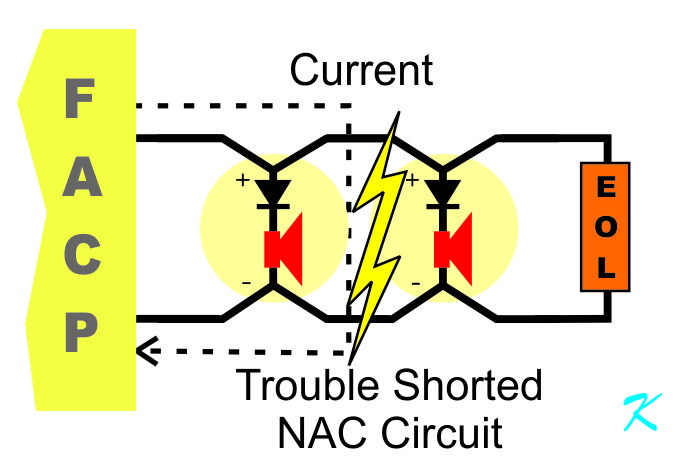
When there's a short, there's too much current on the circuit, and the panel turns on its trouble light and trouble buzzer.
The voltage on the panel's NAC 1 screw terminals will be at zero, or close to zero. The voltage could be higher, however, depending on what is causing the short, but the voltage on the panel's NAC 1 screw terminals will be lower than on the NAC 2 screw terminals.
When there's a short, the display will say something like "TROUBLE SHORT NAC 1" or just "TROUBLE NAC 1".
When the panel turns on its trouble light and turns on its trouble buzzer, then the owner calls for service.
Signal Power Expander (SPX)
Sometimes there's an extra power supply for the horns and strobes. If the NAC 1 goes to a Signal Power Expander (also known as a Booster Power Supply [BPS], a Supplemental Notification Appliance Circuit Power Supply [SNAC], or a NAC Power Supply), then the SPX may be what is having trouble.
If there is a SPX, check it first. Make sure that inside, only the green light is on. That's the easy thing to do. If there are other lights on inside the power supply, deal with them first. Then check the main panel again.
Where the Circuit Runs Depends on the Building, and How the Building is Wired
You are the troubleshooter; you have to figure this out.
An office building has different requirements for wiring the NAC circuit than does a retail establishment. A single level building has different requirements for wiring the NAC circuit, than does a multiple story building.
An apartment building, a condominium building, or even a hotel usually has two types of NAC circuit. One circuit is for the common areas like halls and basement and the other circuit is for the minihorns inside the resident's apartments or condos.
Sounding the Fire Drill versus Walking Around Checking Voltage
In 20 years of troubleshooting, I have almost always walked around without sounding a fire drill. Still, I found the problems with the building's NAC circuit. To get at the horns and strobes, sometimes I've even carried a ladder. Checking out the voltage on each horn or strobe is how I checked for open or shorted wiring.
On the other hand, in those 20 years, I can count on one hand the number of times I sounded the fire drill to find an open or shorted NAC circuit.
Sounding the fire drill, and walking around to find an open or shorted wire annoys people far too much. Usually, even if I asked, the building management said an absolute NO to the fire drill idea.
Minihorns in apartments, condominiums, and long-term hotels are worse. In order to check the minihorns, you have to enter the unit and take the minihorns apart, one unit at a time. Depending on where you're at, using a fire drill can take half an hour to several hours, with someone in maintenance or management in tow.
Sometimes, sounding the horns for half an hour or more causes even more NAC problems. There are occupants that disconnect their fire horns in their units so they are not annoyed anymore. Once they've disconnected their horn, you have to find them... also.
Finding that Open or Shorted Circuit
Usually, the panel doesn't have a lot of information about where the NAC 1 goes in the building. You will have to guess, and then confirm that the guess was good or not good.
If you can figure out how the building is wired, you can divide and conquer. Otherwise, you have to go into each unit, one at a time, and check to find out if the minihorn was disconnected because the resident was annoyed.
Douglas Krantz






